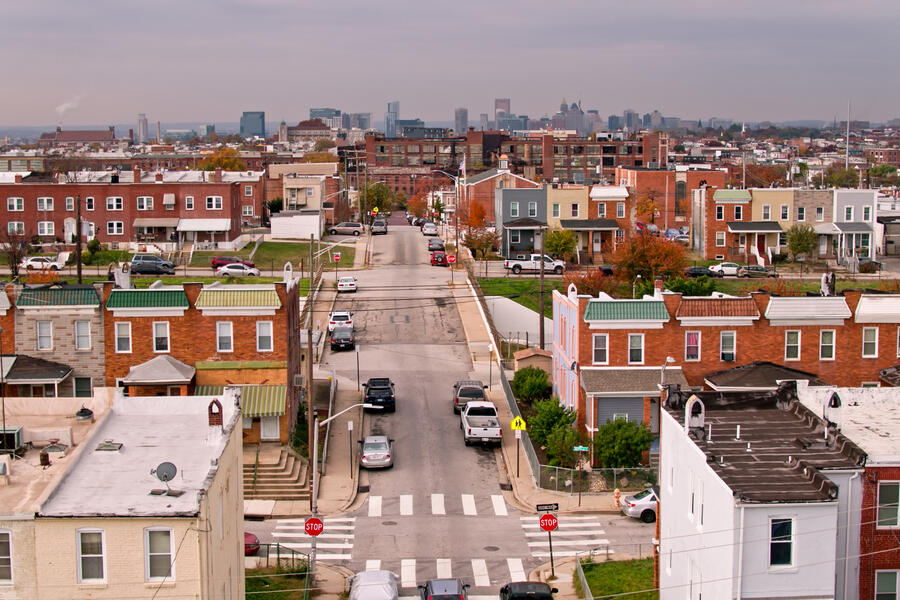- Name
- Doug Donovan
- dougdonovan@jhu.edu
- Office phone
- 443-997-9909
- Cell phone
- 443-462-2947
Fewer Baltimore-area residents experienced food insecurity last year than in 2023 even though researchers found profound racial disparities with hunger and access to grocery stores, according to the latest results from an annual survey by Johns Hopkins University's 21st Century Cities Initiative.
One of the starkest findings of the Baltimore Area Survey in 2023, its inaugural year, was the high level of food insecurity across the region, especially among Black Baltimoreans. But the latest survey found evidence "that food insecurity substantially declined and the drop was largest among Black Baltimore-area residents," according to Michael Bader, faculty director of the 21st Century Cities Initiative, which brings together researchers from across Johns Hopkins to study urban issues.
The survey found that 28% of residents in the Baltimore region reported experiencing food insecurity last year, a 7.5% decline from the previous year. The decline was most pronounced among Black residents, dropping from nearly 54% two years ago to about 37% in 2024. Still, the disparity between white and Black residents experiencing food insecurity "remained profound," the researchers found. Only about 17% of white residents experienced food insecurity last year. Despite the progress, the region's rate of food insecurity remained nearly twice as high as the national average.
Key Takeaways
- Johns Hopkins University's 21st Century Cities Initiative shared results of its second annual Baltimore Area Survey.
- The 163-question survey of nearly 1,500 respondents in Baltimore City and Baltimore County aims to help residents, community groups, policymakers, and businesses better understand the experiences, perceptions, and attitudes of residents over time.
- The survey covers a wide range of topics, including food insecurity, transportation, addiction, policing, and public trust.
Respondents also reported a significant racial disparity in access to grocery stores. About six out of every seven white Baltimore-area residents agreed they had convenient access to grocery stores compared to just 65% of Black residents.
"The rate of people experiencing food insecurity might have declined as inflation slowed over the past year, especially in food prices," Bader said. "Being able to observe these trends in the Baltimore area is one of the advantages of conducting the survey annually."
The 163-question survey of nearly 1,500 respondents in Baltimore city and county was developed in collaboration between Johns Hopkins researchers and community leaders. It aims to help residents, community groups, policymakers, and businesses better understand the experiences, perceptions, and attitudes of fellow residents over time.
Highlights from the 2024 Baltimore Area Survey
Poverty diminishes physical and digital connections
"Profound economic and racial inequality shape how connected Baltimore-area residents can be," the report states.
- More than two-thirds of Baltimore-area residents who made less than $30,000 experienced at least one transportation issue, and less than three in five had high-speed internet in their homes. "The lack of connections physically via transportation and virtually via the internet may make receiving services, health care, and finding work very difficult for poorer Baltimore-area residents," the report states.
- While the share of residents who experienced transportation issues slightly declined from 2023, the report showed that residents who live along the proposed Red Line—a 14-mile stretch of new East-West rail line that would connect communities on either edge of Baltimore—were more likely to experience transportation-related issues such as skipping going places and rescheduling appointments compared to other Baltimoreans.
- 42% of Red Line residents experienced at least one transportation issue, 10 percentage points higher than residents who lived outside of the Red Line corridor.
Positive neighborhood perceptions
More Baltimore City residents said their neighborhoods are getting better than worse, the opposite of the sentiment seen in Baltimore County.
- 85% of Baltimore County residents reported satisfaction with their neighborhoods. Yet more of them (20%) thought things were getting worse than better (13%).
- Seven out of 10 Baltimore City residents reported being satisfied with their neighborhoods. And 28% reported improving conditions compared to 23% who saw declines.
- Where everybody knows your name: 45% of city and county residents know all, most, or some of their neighbors' names.
Trust in government improved
- Fewer residents distrusted local government in both the city and county in 2024 compared to the previous year. Baltimore County residents trusted the government more than city residents.
- Nearly one out of four Baltimore City residents and one out of three Baltimore County residents reported trusting their local government to do the right thing most of the time.
Black residents see higher quality of schools
- "Compared to 2023, the share of Black Baltimore City residents who rated the public schools in their neighborhood as 'high quality' doubled, from 12% to 24%," the report states. Baltimore County's Black residents also reported an increase in school quality—from a quarter of respondents in 2023 to a third of them last year.
- Meanwhile, white residents in both jurisdictions barely changed their less rosy assessments of public schools—with only 13% in the city and 30% in the county reporting schools as either very good or excellent.
"The declining distrust in local government and strong sense of satisfaction residents feel about their neighborhoods give local governments an opportunity to create programs that improve residents' lives," Bader says. "They may choose to focus on helping Baltimore-area's poorest residents become more connected and to work with state government to improve mobility in the region."
Read the reports
Tagged baltimore, 21st century cities








